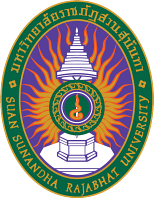แนวทางการตลาดสาหรับสถาบันอุดมศึกษา : มุมมองของนักศึกษาสาขาการท่องเที่ยวและบริการ
คำสำคัญ:
การตลาด, ระดับอุดมศึกษา, สถาบันอุดมศึกษา, นักศึกษา, สาขาการท่องเท่ียวและบริการบทคัดย่อ
บทความนี้มีจุดประสงค์เพื่อศึกษาความเข้าใจเชิงลึกและการให้ความสาคัญต่อ “แนวทางด้านการตลาด สาหรับสถาบันอุดมศึกษา” จากมุมมองของนักศึกษา การดาเนินการวิจัยคร้ังนี้ใช้การวิจัยเชิงคุณภาพ ผ่านการ สัมภาษณ์เชิงลึกและการสนทนากลุ่มกับนักศึกษาท่ีเรียนด้านการท่องเที่ยวและอุตสาหกรรมบริการของ สถาบันอุดมศึกษาจานวน 2 แห่ง คือ วิทยาลัยดุสิตธานีและมหาวิทยาลัยเกษตรศาสตร์ ผลการวิจัยพบว่าใน มุมมองของนักศึกษาทั้งสองสถาบันนั้น ได้มีความเข้าใจและให้ความสาคัญกับแนวทางด้านการตลาดสาหรับ สถาบันอุดมศึกษาแบ่งออกเป็น 4 ประเด็น คือ (1) การประชาสัมพันธ์อย่างมียุทธศาสตร์ต่อสาธารณะ (2) การ สร้างการรับรู้และการยอมรับของแบรนด์ต่อสาธารณะ (3) การสร้างความแตกต่างและจุดยืนของผลิตภัณฑ์และ บริการทางการศึกษา (4) การให้ความสาคัญกับคุณภาพของผลิตภัณฑ์และการบริการทางการศึกษา
เอกสารอ้างอิง
Blackston, M. (1993). Beyond brand personality: building brand relationships. Brand equity and advertising: Advertising’s role in building strong brands, 113-124.
Blythe, J. (2013). Consumer behaviour. 2nd Edition. Sage publications.
Braun, V., & Clarke, V. (2006). Using thematic analysis in psychology. Qualitative research in
psychology, 3(2), 77-101.
Creswell, J. W. (2014). Research design: Qualitative, quantitative, and mixed methods
approaches. Sage publications.
Gibbs, P., & Knapp, M. (2002). Marketing higher and further education: An educator's guide to
promoting courses, departments and institutions. Psychology Press. Hemsley-Brown, J., & Oplatka, I. (2006). Universities in a competitive global marketplace: A
systematic review of the literature on higher education marketing. International Journal
of public sector management, 19(4), 316-338.
Herold, K., Tarkiainen, A., & Sundqvist, S. (2016). How the source of word-of-mouth influences
information processing in the formation of brand attitudes. Journal of Marketing for Higher Education, 26(1), 64-85.
Kotler, P. & Armstrong. (2016). Principles of marketing. Harlow, Essex: Pearson.
Kotler, P., & Fox, K. F. (1985). Strategic marketing for educational institutions. Prentice-Hall. Ming, J. S. K. (2010). Institutional factors influencing students' college choice decision in
Malaysia: A conceptual framework. International Journal of Business and Social
Science, 1(3).
Ng, C. J. W. (2016). ‘Hottest brand, coolest pedagogy’: approaches to corporate branding in
Singapore's higher education sector. Journal of Marketing for Higher Education, 26(1),
41-63.
Nicholls, J., Harris, J., Morgan, E., Clarke, K., & Sims, D. (1995). Marketing higher education: the
MBA experience. International Journal of Educational Management, 9(2), 31-38. Nopkeisorn, T. (2008). Qualitative research methodology Volume 1: Manual for applied research
for development of people, organizations and society. Faculty of Medicine, Naresuan
University.
Oplatka, I., & Hemsley-Brown, J. (2004). The research on school marketing: Current issues and
future directions. Journal of educational administration, 42(3), 375-400. Tantivorakulchai, K. (2015). Thai students' destination choice for higher education: a
comparative study on US, UK and Australia.
ดาวน์โหลด
เผยแพร่แล้ว
รูปแบบการอ้างอิง
ฉบับ
ประเภทบทความ
สัญญาอนุญาต
บทความที่ได้รับการตีพิมพ์เป็นลิขสิทธิ์ของ สถาบันวิจัยและพัฒนา มหาวิทยาลัยราชภัฎสวนสุนันทา
ข้อความที่ปรากฏในบทความแต่ละเรื่องในวารสารวิชาการเล่มนี้เป็นความคิดเห็นส่วนตัวของผู้เขียนแต่ละท่านไม่เกี่ยวข้องกับมหาวิทยาลัยราชภัฎสวนสุนันทา และคณาจารย์ท่านอื่นๆในมหาวิทยาลัยฯ แต่อย่างใด ความรับผิดชอบองค์ประกอบทั้งหมดของบทความแต่ละเรื่องเป็นของผู้เขียนแต่ละท่าน หากมีความผิดพลาดใดๆ ผู้เขียนแต่ละท่านจะรับผิดชอบบทความของตนเองแต่ผู้เดียว





